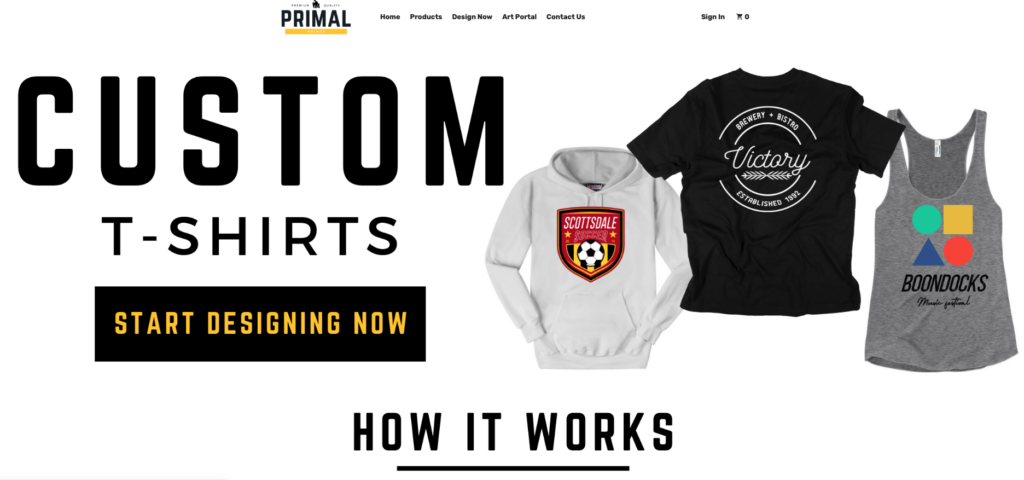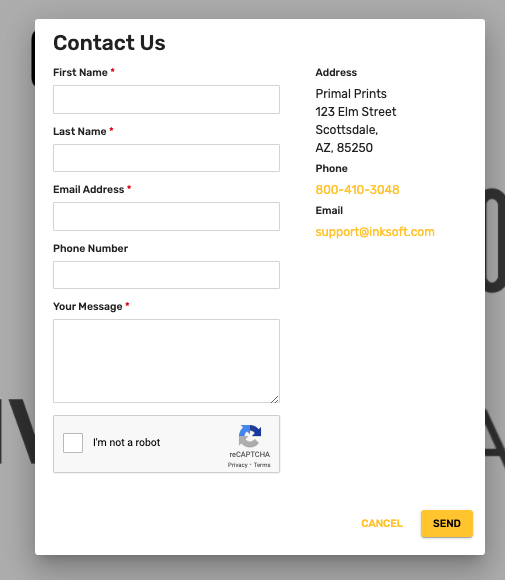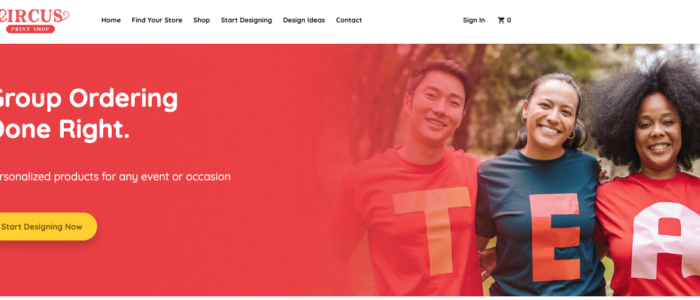A professional website is the foundation of your shop’s online presence and can be a significant tool in helping your shop grow beyond a small list of local customers. Plus, it’s a way for businesses to stay “open” 24/7 so that people can find you and tap you for their printing jobs whenever needed, versus having to line up a consultation visit.
Here are seven elements every print shop website needs to thrive, plus tips on promoting your website to your current and prospective customers.
- Consistent and Clear Branding
Your print shop website should reflect your company’s branding so people recognize your business without confusion. That means using consistent branding elements like your shop’s logo, color schemes, and font on any of your company’s swag to give customers a lasting impression.
Think of it this way: your website is an extension of your physical location. Whatever your shop uses to stand out on the block and let people know who you are, those elements should carry over to your website.
One of this element’s most essential parts is ensuring consistency with your shop’s name. Unless you’re using your website to run a separate business, make sure whatever your walk-in customers know your shop by, you’re using that same branding on the website. For example, if you’re advertising to your local customers as “Bob’s T-Shirt Shack,” titling your shop’s website with something like “Bob’s T-Shirt Emporium and More” might confuse potential customers referred to you from existing clients.
Your website is also the modern-day business card, a way potential customers will decide if they want to do business with you. First impressions are critical, so you want to make it count.

- Smooth Navigation
Like it or not, your online customers have become accustomed to shopping experiences where everything is laid out for them, and they don’t need to spend much time looking for what they want. One 2019 study found that customers spend about 38 seconds on a page when shopping online. That’s a small window to catch someone’s attention, so having everything lined up simply and clearly will benefit your business. Depending on your services, make sure you’ve organized everything into logical categories and, if necessary, include a search feature so people can pull up exactly what they need.
For screen print shop websites, one of the most effective ways to set up your website is to have your primary services on the front page and easy to find.
This video shows a great example of this practice in action.
Set up your site’s front page with call-to-action buttons that feature common requests like:
“Get a Quote”
“Start a Reorder”
“Build a Design”
In short, simple is better. Complex, busy websites are distracting and confusing. Including the above, plus basics like “What we do,” “What we offer,” and “How to contact us,” are sufficient. If you want to add a personal touch, visual examples of your work, customer testimonials, a short company bio, and team member spotlights are a nice addition.
Just make sure you don’t crowd the front page of your website with too many subheadings; instead, link out to these types of nice-to-haves on a separate page.
Some businesses also link out to their social media pages from their website. This is an excellent practice since modern customers frequently connect with companies they like on social media. One thing to consider is to only link to accounts you often use. Otherwise, you risk having customers trying to connect on social media and not hearing back from you.
- Responsive Design
You probably use your phone more than you did 10-15 years ago for shopping, browsing the web, and business tasks, and your customers are the same. In a 2022 Pew Research Study, 76% of Americans used their phone to shop. With that logic, it makes sense to ensure your shop’s website is mobile-optimized and responsive so that regardless of what kind of device your customers visit your site on, they get the same hassle-free experience. That way, your website will display correctly on smartphones, tablets, and desktops, providing a seamless browsing experience.
If you don’t have the time, budget, or expertise to build a website from scratch, you can use InkSoft Stores as a resource to create a professional print shop website with a responsive design. There’s a simple website style editor that helps you create a site that matches your company’s colors and branding, plus the option to add additional pages so you can have subsections on your site.
- Fast Loading Speed
A fast-loading website ties into some of the other components we mentioned, especially the 38 seconds someone spends on a website. Suppose customers wait for images, videos, and other media to load on your website while all they want to do is request a quote. It’s another area where you can risk losing business since they’ll just head to another shop’s site that loads faster and smoother. There are a few key ways to optimize your website speed, including:
- Compress images: Using images formatted for the web will improve load times. You can do this with pro graphics software and simple online programs like Canva and Pixlr.
- Choose a reputable hosting company: A legitimate web hosting service typically offers better load times. Make sure you shop around and compare before going with the cheapest options. Most legitimate hosting companies can give you information on their performance speed. And, if they don’t have that kind of information (or won’t share it), it’s probably not worth running your business with them.
- Minimizing code: Minimizing your code can help with your load times, and you can typically do this with free plugins.
If you want a deeper dive into optimizing your website speed, including tips on minimizing code, check out this handy set of tips.
- Contact Information
This element might sound obvious, but customers need a simple way to contact you if they have questions or concerns about setting up an order. Prominently displaying your contact information on your website makes it easy for potential customers to contact you.
Even if your shop typically does business over the phone, you’ll want to include an email address where customers can reach you. Also, make sure to have a simple call-to-action, like a “Contact Us” button on each page of your print shop website, so getting in touch is simple for your customers.

- Secure and Credible
In addition to hassle-free experiences, modern customers want to do business with websites they know are secure and trustworthy. E-commerce sites can be particularly vulnerable to hacking since valuable information like credit card numbers are exchanged. So, you want to ensure your customers feel safe and secure sharing billing information and payment details online.
You can ensure your website is secure by implementing SSL certificates, which help encrypt sensitive customer data. A prominently displayed security badge lets customers know your site is secured with SSL. Display security badges and trust seals to reassure visitors that their information is safe. These extra steps will help build trust and credibility with new and existing customers.
Part of having a secure website also means giving your customers a safe, reliable way to pay for transactions. Programs like InkSoft embedded payments use industry-leading security to ensure secure transactions between you and your customers.
- Search Engine Optimization (SEO)
Outside of customer-facing features, you’ll want to ensure your shop’s website is optimized on the backend with relevant keywords, meta tags, and descriptive URLs. Paying extra attention to these components helps improve your ranking in Google search results and helps drive more overall traffic to your website.
To dial in relevant keywords, it’s typically good to start with some keyword research. One common way many businesses do this is with the Google Keyword Planner, which helps you get a broader scope of what kinds of terms people are searching for. However, countless other keyword planning services are available now through companies like Ahrefs, Semrush, and MOZ, to name a few.
Here’s a comprehensive list of top keyword planners currently available to help you optimize your website.
Whichever keywords you decide on, you’ll want them to be under your Heading tags. And the headings higher up at the top of your webpage are the most important. So, for example, if you’re a shop based in L.A. and you offer screen printing, your H1 title tags should say something like “Los Angeles Screen Printing.”
Another part of locking in your SEO game is setting up your Google business listing and ensuring all the information is current. Many businesses have unclaimed listings without links to their websites or sometimes a link to the wrong website. Even if these mistakes aren’t of your doing, it can reflect poorly on your business, so make sure all this information is up to date.
If your shop appears in Google search results, but you haven’t configured your listing, you’ll need to verify it first to finalize details. The information can take a couple of weeks to update, so the sooner you can verify the information, the better. Here’s Google’s step-by-step guide on how to confirm your listing.
Promoting Your Website
You can also promote your print shop website to drive more traffic with several strategies. One of the most common ways is through word-of-mouth. In the digital age, that comes in the form of online reviews from your customers.
The more customer testimonials and quotes you can feature on your social media channels and website, the better you’ll establish credibility and trust with future customers.
Social proof is a big part of how people do business with companies online, so any glowing recommendations from your customers go a long way. Written reviews are great, but if your customers can also provide video testimonials, these can be valuable pieces of social proof that prospects will see and understand why your shop is so special.
With social media channels like Facebook, customers can leave reviews on your page so other potential clients can get a sense of your shop’s reputation before they visit your site. To that end, make sure any social channels you use have a link back to your website so you can keep that cyclical traffic going between your social profiles and your shop’s website.
If you have the time and resources, you can also run a newsletter that regularly updates customers on what your shop is up to. Your newsletter can be as simple as a monthly roundup with information on some business highlights, community involvement, and what kind of new offerings or features customers can look forward to on your website.
This strategy helps keep the interaction between you and customers fresh and keeps them returning to check out your website.
Partners and Collaborators
You can also take your testimonials and reviews to the next level if you have business owners and entrepreneurs you print merch for with a steady following. Thanks to the power of the internet, these collaborators don’t always have to be local business owners, either. You can collaborate with industry experts and other businesses nationwide by running co-branded social media campaigns, sharing email lists, and creating content promoting both your websites and brands like videos.
With a well-designed and optimized website, you can grow your customer base and overall credibility and stay competitive with other print shops in the online marketplace. And with a bit of extra promotion, you can drive more visitors to your site so people know you as the go-to print shop for all their custom-printed merchandise needs.



Comments are closed.